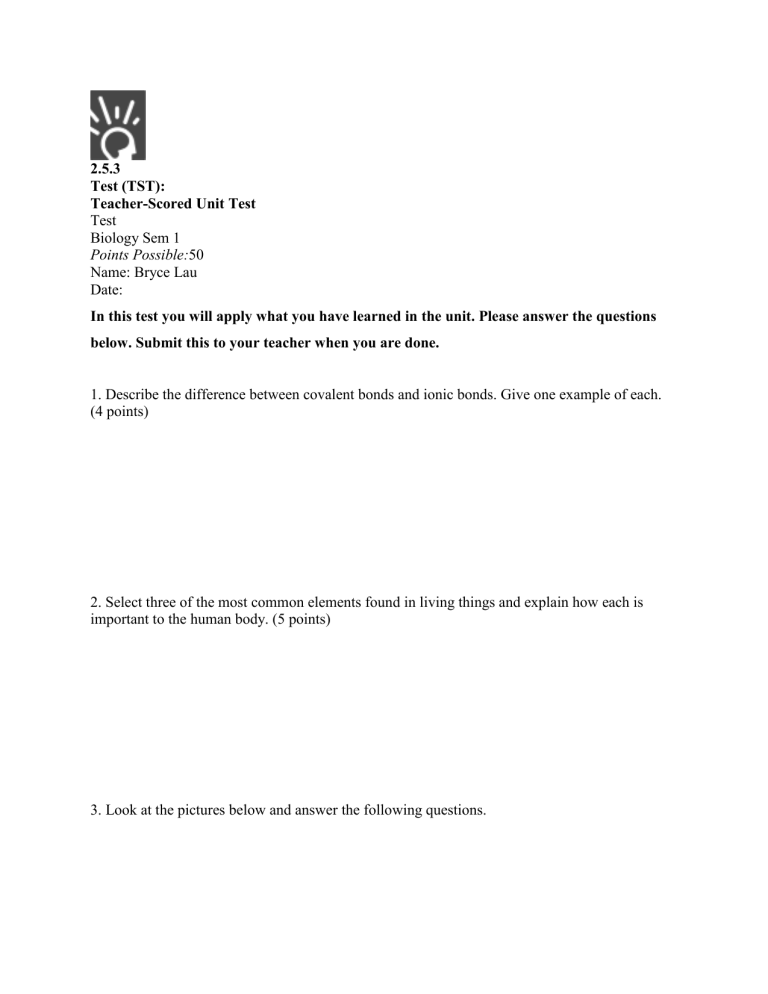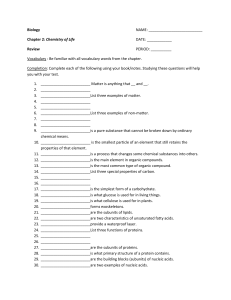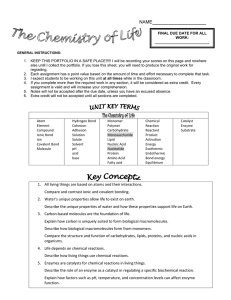
2.5.3 Test (TST): Teacher-Scored Unit Test Test Biology Sem 1 Points Possible:50 Name: Bryce Lau Date: In this test you will apply what you have learned in the unit. Please answer the questions below. Submit this to your teacher when you are done. 1. Describe the difference between covalent bonds and ionic bonds. Give one example of each. (4 points) 2. Select three of the most common elements found in living things and explain how each is important to the human body. (5 points) 3. Look at the pictures below and answer the following questions. a) How do the carbon bonds affect the shapes of fatty acids? (4 points) b) Look at the diagram of the cell membrane, which is a double layer of lipids that forms the outer covering of cells. How does the structure of fatty acids enable them to function in the cell membrane? Why are unsaturated fatty acids better than saturated fatty acids at letting substances into and out of the cell? (4 points) 4. Compare the structures and functions of the following groups of macromolecules. a) Carbohydrates and proteins (2 points) b) Lipids and nucleic acids (2 points) 5. Describe the role of water in a dehydration reaction. Mention a specific dehydration reaction in your answer. (4 points) 6. a) Why are some molecules polar and others nonpolar? (1 point) b) How is a hydrogen bond different from a covalent bond? Draw a diagram of several water molecules, and label a hydrogen bond and a covalent bond. (4 points) 7. Students are measuring the rate of enzyme activity. The graph below shows the rate of enzyme action as they increase the temperature. a) Describe how the activity of the enzyme changes as the temperature changes. (4 points) b) What is one possible reason the enzyme is less effective at high temperatures? (2 points) 8. A salad contains lettuce, eggs, bread crumbs, and olive oil. Name two macromolecules contained in this salad, and describe their effect on the human body. (4 points) 9. a) Describe the structure of a nucleic acid, and explain how this structure enables nucleic acids to contain a vast amount of information. What part of a nucleic acid allows it to be used to form a code? (4 points) b) How would the structure of a fish's DNA compare with the structure of a lion's DNA? (2 points) 10. a) How is water important to plants? (2 points) b) How is water able to move upward inside the stems of plants? (2 points) Copyright © 2019 Apex Learning Inc. Use of this material is subject to Apex Learning's Terms of Use. Any unauthorized copying, reuse, or redistribution is prohibited. Apex Learning ® and the Apex Learning Logo are registered trademarks of Apex Learning Inc.


